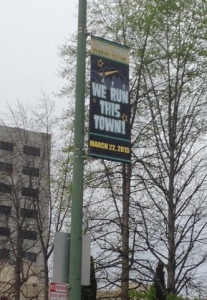 The average American is hit with 5,000 messages a day. From television commercials to billboards, Facebook to bathroom stalls, messages flood our lives; some sticking with us forever, others flushing away as quickly as they came.
The average American is hit with 5,000 messages a day. From television commercials to billboards, Facebook to bathroom stalls, messages flood our lives; some sticking with us forever, others flushing away as quickly as they came.
Clever, catchy, memorable, or odd, whatever your messages are, there are two things that you must always ask yourself:
- Do they make sense?
- Do they move someone to take action?
The first one may seem obvious. Yet, nonprofit organizations and corporations alike continue to miss the boat on making sense. While messages can be powerful, they can also be confusing. That’s why I’m blogging on this topic again (check out my first post, “What’s A Word Worth? How One Word Can Take You “Off Brand”).
The second question, “Do they move someone to take action?” is often left out of the equation altogether, even though that should be the purpose of messages (unless you’re just building awareness, which is powerful as well, but if you have a small budget, your messages need to give you the most bang for your buck).
During my bi-weekly drives from Fort Collins to Denver and back, I continue to be baffled by a billboard for the University of Northern Colorado (UNC). It appears to be an ad for its meteorology department, and while the attempted play on the word “storming” makes sense, the use of “brainstorming” means nothing (note, the image above is the same as the billboard, I just opted use an online image rather than take a photo driving down I-25). Is the ad trying to say that you can brainstorm at UNC? Or that the professor is a brain, storming through life? Or … the billboard has roughly 10 seconds to capture a person’s attention and move her to action. After multiple exposures, this ad just makes me frustrated and unimpressed with UNC’s marketing department. Clever is one thing. Confusing is another.
 A great example of messaging that works is marketing for Oakland’s Running Festival (see image on right, and apologies for the poor image quality as it doesn’t do the campaign justice). Granted, I’m more in the market for running races than I am for college, but still, it’s clear, compelling, and moves me to action. It also immediately makes me feel empowered and like I am part of a community. “We run this town,” is a rallying cry. If I hadn’t been in town a week too late, I would have likely signed up for the race.
A great example of messaging that works is marketing for Oakland’s Running Festival (see image on right, and apologies for the poor image quality as it doesn’t do the campaign justice). Granted, I’m more in the market for running races than I am for college, but still, it’s clear, compelling, and moves me to action. It also immediately makes me feel empowered and like I am part of a community. “We run this town,” is a rallying cry. If I hadn’t been in town a week too late, I would have likely signed up for the race.
Remember, your message is one of 5,000 ads someone is seeing in a day. You only have a few seconds to make an impact and move him to action. So, before you jump on the next word or phrase to promote your brand or business, ask yourself, “What am I really trying to say?” and “Will it move someone to action?” If you don’t know how to answer the first question, don’t expect your consumers to, no matter how clever you make your messaging. And if you can’t say “yes” to the second one, then you better have a huge marketing budget or you need to reevaluate your marketing plan.